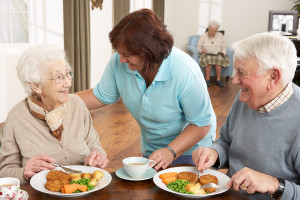How to Keep Seniors’ Caloric Intake High
by Michelle Kicherer of www.BananaPitch.com

Wondering how to keep seniors’ caloric intake high? A condition very common with the elderly is called anorexia, meaning “loss of appetite” (not to be confused with the eating disorder, anorexia nervosa). Often, older adults lose interest in food for a variety of reasons. The urge to eat is frequently not there, and when they do eat, it may be a small quantity, due to physical restrictions – for example, difficult to chew or difficult to digest.
It is important to make sure your senior is eating enough, to maintain a healthy weight, to keep their muscle strength, and to increase energy level and alertness. If the senior in your life is not maintaining a high enough weight, is important to think about what kinds of foods they are being served, and how. Some things to keep in mind:
- Serve them foods they like! Take into account personal and ethnic choices.
- Eat together! People are more likely to eat more if they enjoy meal time .
- Make food flavorful, but be careful with garlic, onions and spicy foods, as these often cause indigestion.
- Make food colorful! Not only does a colorful plate mean it is varied in nutrients, it also means that the food looks more appealing, which increases one’s desire to eat it.
- If swallowing is an issue, some may need blended foods, or foods with a consistent texture throughout. It is also important to also make sure liquids are thick enough. Note: Talk to a physician about what high calorie beverages you can make or buy, and what thickening agents to add, if any.
- Digesting food often becomes difficult as people age. Make sure your senior is getting enough fiber (typically between 20-30 grams a day, depending on diet) and drinking plenty of water (aim for at about 8 cups per day, or 64 ounces).
- Everyone is different! What one person likes, another does not; what one person can digest, another cannot. Make sure your elder’s meal plan is catered to them…no pun intended.





